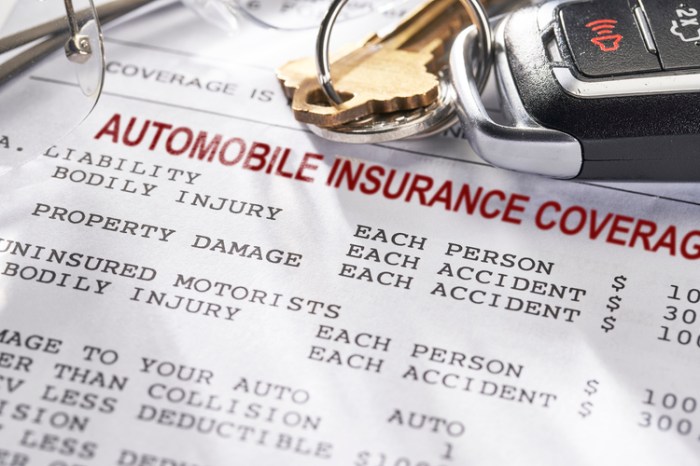Navigating the world of auto insurance can feel like driving through a dense fog. The sheer number of options and varying levels of coverage often leave drivers confused and overwhelmed. This guide cuts through the complexity, focusing specifically on basic auto insurance. We’ll explore what it covers, what it doesn’t, and how to determine if it’s the right fit for your needs. Understanding the fundamentals is the first step to securing affordable and adequate protection on the road.
From defining the core components of a basic policy to understanding the factors that influence premiums, we’ll provide a clear and concise overview. We’ll also examine the process of obtaining quotes, interpreting policy documents, and filing a claim, equipping you with the knowledge to make informed decisions about your auto insurance.
Defining Basic Auto Insurance

Basic auto insurance provides a foundational level of protection against financial losses resulting from car accidents. It’s designed to meet minimum state requirements, offering a safety net for essential coverage, but often lacking the extensive protection of more comprehensive plans. Understanding its components and limitations is crucial for making informed decisions about your insurance needs.
A basic auto insurance policy typically includes liability coverage. This covers bodily injury and property damage you cause to others in an accident. It’s crucial to note that liability coverage protects others, not yourself or your vehicle. The policy will specify limits, such as $25,000 per person for bodily injury and $50,000 per accident for all injuries. Many states mandate minimum liability coverage, and failing to meet these requirements can result in significant legal and financial repercussions. In addition to liability, basic policies often include uninsured/underinsured motorist (UM/UIM) property damage coverage, protecting you if you’re involved in an accident with a driver who lacks sufficient insurance or is uninsured. This coverage helps compensate for damages to your vehicle in such scenarios.
Essential Components of Basic Auto Insurance
Basic auto insurance policies usually consist of two primary components: bodily injury liability and property damage liability. Bodily injury liability covers medical expenses and other damages incurred by the other party involved in an accident if you are at fault. Property damage liability covers the cost of repairing or replacing the other driver’s vehicle or property damaged due to your negligence. The specific amounts covered are determined by the policy limits chosen, which should be carefully considered based on individual financial circumstances and risk tolerance. Higher limits offer greater protection but also come with higher premiums. It is also important to understand that the policy typically does not cover your own injuries or vehicle damage.
Comparison with Comprehensive Options
Comprehensive auto insurance policies offer significantly broader coverage compared to basic policies. While basic policies primarily focus on liability, comprehensive options typically include collision coverage (for damage to your own vehicle in an accident), comprehensive coverage (for damage caused by events other than collisions, such as theft, fire, or vandalism), and potentially additional benefits like roadside assistance or rental car reimbursement. The trade-off is a higher premium for the increased protection. For example, a basic policy might only cost $500 annually, while a comprehensive policy could cost $1200 or more depending on factors like your driving record, location, and the vehicle itself. The choice depends on individual risk tolerance and financial capacity.
Typical Exclusions in Basic Auto Insurance Policies
Basic auto insurance policies typically exclude coverage for various scenarios. These exclusions often include damage to your own vehicle resulting from a collision (unless you have collision coverage, which is not included in a basic policy), injuries to you or your passengers, and damage caused by intentional acts. Furthermore, coverage might be limited or excluded for certain types of accidents, such as those involving driving under the influence of alcohol or drugs. It is vital to carefully review the policy documents to fully understand the specific exclusions and limitations to avoid unexpected costs in the event of an accident. For instance, if you are involved in an accident while driving someone else’s car without permission, your basic policy likely won’t cover the damages.
Factors Affecting Basic Auto Insurance Premiums

Several key factors influence the cost of your basic auto insurance premium. Understanding these factors can help you make informed decisions and potentially lower your costs. These factors generally fall into categories related to the driver, the vehicle, and the location.
Driver Profile
Your personal characteristics significantly impact your insurance premium. Insurers assess risk based on your driving history, age, and even your credit score. A clean driving record with no accidents or traffic violations will typically result in lower premiums compared to someone with multiple incidents. Younger drivers, statistically more prone to accidents, often face higher premiums than older, more experienced drivers. Similarly, your credit score, reflecting your financial responsibility, can influence your premium; a higher credit score often correlates with lower premiums.
Vehicle Type
The type of vehicle you insure plays a crucial role in determining your premium. Higher-value vehicles, luxury cars, or those with a history of theft or accidents, generally command higher premiums due to the increased risk and repair costs associated with them. The vehicle’s safety features also factor into the equation; cars with advanced safety technologies might receive discounts due to their reduced accident risk. The vehicle’s age and mileage can also influence premiums, with newer vehicles often costing more to insure than older ones.
Location
Your geographic location significantly affects your insurance premium. Areas with higher rates of theft, accidents, or vandalism typically have higher insurance premiums to reflect the increased risk. Insurers consider factors like population density, traffic congestion, and crime rates when determining premiums for specific locations. Rural areas might have lower premiums than densely populated urban centers.
Impact of Driving History and Credit Score
Driving history and credit score are two significant factors used in premium calculations. A clean driving record, free of accidents and violations, results in lower premiums. Each accident or violation adds to the perceived risk, leading to higher premiums. Similarly, a good credit score often indicates financial responsibility, which insurers view favorably, resulting in lower premiums. Conversely, a poor credit score may signal a higher risk, leading to increased premiums. Insurers often use proprietary algorithms to weigh these factors, alongside others, to calculate individual premiums.
| Factor | Low Risk/Impact on Premium | High Risk/Impact on Premium |
|---|---|---|
| Driver Age | 30+ years old, experienced driver | Under 25 years old, inexperienced driver |
| Driving History | Clean record, no accidents or violations | Multiple accidents, speeding tickets, DUI |
| Vehicle Type | Small, fuel-efficient car with good safety features | Luxury car, high-performance vehicle, history of theft |
| Location | Low crime rate, rural area | High crime rate, urban area with heavy traffic |
| Credit Score | High credit score (700+) | Low credit score (below 600) |
Filing a Claim Under Basic Auto Insurance
Filing a claim after a car accident can be a stressful experience, but understanding the process can help alleviate some anxiety. This section Artikels the steps involved in filing a claim under a basic auto insurance policy, from the immediate aftermath of an accident to the final settlement. Remember, specific procedures may vary slightly depending on your insurance provider, so always refer to your policy documents for detailed instructions.
The Immediate Aftermath of an Accident
Following a car accident, your priority should be ensuring the safety of yourself and others involved. Call emergency services if anyone is injured. Then, gather information at the scene to facilitate a smooth claims process. This includes exchanging information with all other drivers involved, such as driver’s license numbers, insurance details, and contact information. Note the location of the accident, time of the accident, and a description of what happened. If possible, take photos or videos of the damage to all vehicles involved, as well as the surrounding area, documenting the scene and any visible injuries.
Reporting the Accident to Your Insurer
Promptly report the accident to your insurance company. Most policies require notification within a specific timeframe, often 24-48 hours. Be prepared to provide the details you gathered at the scene. Your insurer will likely assign a claims adjuster to your case who will guide you through the subsequent steps.
Documentation Needed for a Claim
Comprehensive documentation is crucial for a successful claim. This typically includes a completed accident report form provided by your insurer, copies of driver’s licenses and insurance cards for all parties involved, police reports (if applicable), photographs and videos of the accident scene and vehicle damage, medical records and bills (if injuries occurred), repair estimates from certified mechanics, and any witness statements. The more detailed and complete your documentation, the smoother the claims process will be.
Claim Processing and Settlement Timeline
The time it takes to process and settle a claim varies depending on the complexity of the accident and the amount of damage. Simple claims with minimal damage might be resolved within a few weeks, while more complex claims involving significant damage or injuries can take several months. Your insurer will keep you updated on the progress of your claim. Factors influencing the timeline include the need for independent assessments, legal involvement, and the negotiation of settlements between involved parties. For example, a minor fender bender with readily available repair estimates might be settled quickly, while a multi-vehicle accident with significant injuries and disputed liability could take considerably longer.
Last Point

Securing adequate auto insurance is a crucial step in responsible driving. While basic auto insurance offers foundational protection, it’s essential to carefully assess your individual needs and risk tolerance. By understanding the limitations of basic coverage and exploring the possibility of supplemental options, you can ensure you have the right level of protection for yourself, your vehicle, and others on the road. This guide serves as a starting point; further research and consultation with an insurance professional are recommended to tailor a policy perfectly suited to your circumstances.
FAQ Summary
What is the difference between liability and collision coverage?
Liability coverage pays for damages you cause to others’ property or injuries you inflict on others in an accident. Collision coverage pays for damage to your vehicle, regardless of fault.
Can I use my credit score to get a lower premium?
In many states, insurers consider credit scores when determining premiums. A good credit score can often lead to lower rates.
What happens if I’m in an accident and don’t have enough liability coverage?
If your liability coverage is insufficient to cover the damages or injuries you caused, you could be held personally liable for the remaining amount.
How long does it take to process a claim?
Claim processing times vary depending on the insurer and the complexity of the claim, but can range from a few days to several weeks.
What should I do immediately after an accident?
Ensure everyone is safe, call emergency services if needed, exchange information with other drivers, and contact your insurer to report the accident.